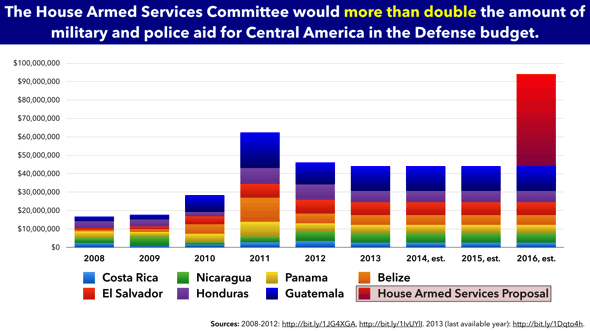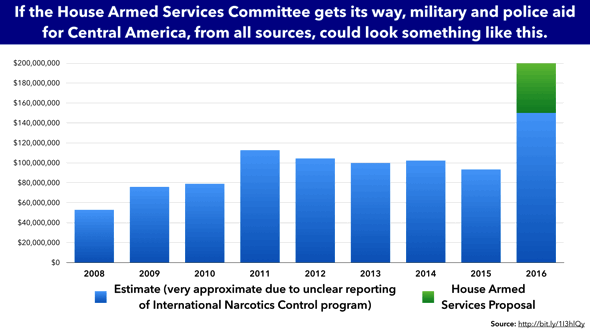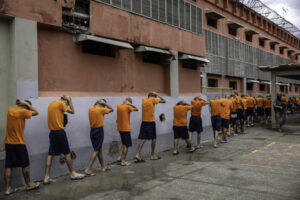The proposed aid, not part of the “Alliance for Prosperity,” follows the old drug-war model
In February, when the Obama administration proposed US$1 billion in new aid to Central America, we noted that, unlike past big aid packages for the Americas, this one did not place military and police forces at the center:
The majority of the aid in this proposal—at least 80 percent—goes to civilian institutions, civil society, and economic development, in recognition of the need to address the root causes underlying the violence and lack of opportunity driving migration. Further details about the aid will certainly reveal this to be a less-than-perfect package, but in broad strokes it represents an important shift.
This shift apparently isn’t for everyone.
This week, the House Armed Services Committee threw an extra US$50 million in drug war aid for Central America into the 2016 Defense bill. The draft bill [PDF] from Committee Chairman Rep. Mac Thornberry (R-Texas) complains that “none of the President’s $1,000,000,000 budget request for the strategy for United States engagement in Central America includes any funding for Department of Defense programs in the region.”
But this was not an oversight. The President’s request for Central America would channel 78 percent of that US$1 billion through USAID, and perhaps half of the rest would go to rule of law initiatives and community policing. A significant part of this proposed package would go toward making Central Americans feel safer at home in Central America through violence prevention.
That is not what the Defense Department’s counter-drug military aid account is designed to do. But the House Armed Services Committee’s bill language would more than double the amount of aid this account provides Central America:
[T]he committee recommends an increase of $50.0 million for Department of Defense Central American programs within the Drug Interdiction & Counter-drug Activities appropriation. This funding should be focused on aerial and maritime interdiction capabilities, building partnership capacity, and increasing detection and monitoring of illicit trafficking in Central America, and complement the Department of State efforts.
This is not the time to use scarce resources on building the capacities of Central America’s militaries, whose internal-security roles are expanding while they continue to avoid accountability for past and present human rights abuse and corruption. If another US$50 million is available, it should go to supporting community-level violence prevention initiatives, sweeping judicial and police reforms, protection of human rights defenders and a free press, tackling corruption, opportunities for at-risk youth, and similar needs.
The proposed US$50 million in new military aid would be part of the US$600 billion Defense Department budget, which since 1991 can be used to give aid to foreign military and police forces for counter-drug purposes. It would be managed by the Defense Department, not the State Department. The House Armed Services Committee is proposing to give the Pentagon US$50 million more for such aid than it requested of Congress.
The Obama administration’s big aid request, on the other hand, would be part of the US$50 billion State Department and foreign aid budget. We oppose using the Defense budget to boost a category of assistance that raises human rights concerns and offers an inappropriate response to public security challenges.



